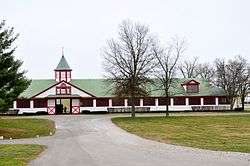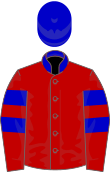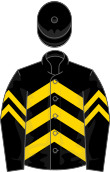Calumet Farm
 Stables at Calumet Farm, January 2012 | |
|
Horse breeding farm and Thoroughbred racing stable | |
| Industry | Thoroughbred horse racing |
| Headquarters | Lexington, Kentucky |
Key people |
|
| Honors |
|---|
| Eclipse Award for Outstanding Breeder (1990) |
Calumet Farm is a 762-acre (3.08 km2) Thoroughbred breeding and training farm established in 1924 in Lexington, Kentucky, United States by William Monroe Wright, founding owner of the Calumet Baking Powder Company. Calumet is located in the heart of the Bluegrass, a well-known horse breeding region. Calumet Farm has a record history of Kentucky Derby and Triple Crown winners and throughout its history of over 87 years, it has produced some of the greatest Thoroughbred horses of all time.
History
Though Calumet was initially based in Libertyville, Illinois, the more favorable climate of Kentucky made it a better place for a horse farm and led to W. M. Wright acquiring the land and relocating his Standardbred breeding operation. At a time in American history when harness racing was the most popular type of horse racing, in 1931 the farm's trotter "Calumet Butler" won the most prestigious event of the day, the Hambletonian.[3]
Following the death of W. M. Wright, in 1932 his son Warren Wright, Sr. took over the business and began converting it to Thoroughbred breeding and training. His acquisition of quality breeding stock saw Calumet Farm develop into one of North America's most successful stables in Thoroughbred racing history. Calumet Farm was added to the National Register of Historic Places in 1991.[4] The Pennsylvania Railroad named its baggage car #5868 the "Calumet Farm".[5]
The farm's breeding success was notably anchored by a part ownership in Blenheim II, a stallion imported from England, and its Foundation Sire, Bull Lea. Calumet Farm has produced eight Kentucky Derby winners, more than any other operation in U.S. racing history. As well, Calumet Farm is both the leading breeder and owner of Preakness Stakes winners with seven each. From the farm's many great foals, two colts also won the U.S. Triple Crown and three females won the Triple Crown for fillies.
Under Warren Wright, Sr. and his wife Lucille Parker Wright who inherited the property on his death in 1950, Calumet was the number one money-earning farm in racing for twelve years. Among the farm's best-known horses are Nellie Flag, Armed, Two Lea, Mar-Kell, A Gleam, Twilight Tear, Mark-Ye-Well, A Glitter, Bewitch, Coaltown, Real Delight, Bardstown, Our Mims, Davona Dale, Alydar, and Before Dawn.
_(2).jpg)
The names of the Calumet Farm official winners of the Kentucky Derby, and the years they won, are: Whirlaway (1941), Pensive (1944), Citation (1948), Ponder (sired by Pensive - 1949), Hill Gail (1952), Iron Liege (1957), Tim Tam (1958), Forward Pass (1968 by DQ).
Two of these greats, (Whirlaway (1941) and Citation (1948)) are the United States Triple Crown of Thoroughbred Racing champions.[6] In all, the farm produced eleven horses that have been inducted into the National Museum of Racing and Hall of Fame.[7]
Lucille Wright died in 1982 and according to the terms of her husband's will, the farm went to the heirs of their only child Warren Wright, Jr. (1920–1978). Son-in-law John Thomas Lundy (J.T.), married to Lucille "Cindy" Wright, took over as head of operations and president.[4]
Calumet Farm won the 1990 Eclipse Award for Outstanding Breeder. In November of that year, details surrounding the death of 15-year-old Alydar - America's leading sire of the time - and the collection of a $36 million insurance policy brought a cloud of suspicion over the business. Under Calumet president J.T. Lundy, mismanagement and fraud had left the farm with a massive debt load that led Calumet Farms to file for bankruptcy protection in 1991 as they were losing one million dollars a month.[8] After years of legal proceedings, in 2000, J.T. Lundy along with Gary Matthews, the farm's former attorney and chief financial officer, were convicted of fraud and bribery and sent to prison.[9]


In 1992, a trust established by Henryk de Kwiatkowski, a Polish-born Canadian citizen, purchased Calumet Farm, saving it from possible liquidation. Since 1992, the farm has been fully restored to its former beauty.
In 2012, the Calumet Investment Group bought Calumet Farm from the de Kwiatkowski Trust for over $36 million. Calumet Investment Group in turn leased it to Brad M. Kelley,[10] believed to be a member of the investment group.[11][12] Kelley's horses race under the name of Calumet Farm, but they carry Kelley's black and gold racing colors, as the original "Devil's Red and Blue" silks of Calumet had been sold to a Brazilian investment group.[13] The win of Oxbow in the 2013 Preakness Stakes marked the return of Calumet to the winner's circle of a Triple Crown race for the first time since 1968.[14]
References
- ↑ http://calumetfarm.com/history
- ↑ http://www2.kyeb.uscourts.gov/opin/leeopin/Wright,%20Bertha%2093-5050%201-23-95.html
- ↑ William F. Reed (1991-09-02). "The Bluegrass breeding ground of nine Kentucky Derby - 09.02.91 - SI Vault". Sportsillustrated.cnn.com. Retrieved 2013-05-31.
- 1 2 Anne Hagedorn Auerbach. "Wild Ride | Anne Hagedorn Auerbach | Macmillan". Us.macmillan.com. Retrieved 2013-05-31.
- ↑ June 27, 1948 Milwaukee Journal article on Calumet Farm
- ↑ "Champions: America's Greatest Thoroughbreds | Daily Racing Form". Drf.com. 2013-05-20. Retrieved 2013-05-31.
- ↑ "National Museum of Racing, Hall of Fame, Thoroughbred Horses". Racingmuseum.org. Retrieved 2013-05-31.
- ↑ William Nack; Lester Munson (November 16, 1992). "Questions About Alydar". Sports Illustrated. Retrieved January 5, 2013.
- ↑ June 2001 Texas Monthly article titled The Killing of Alydar by Skip Hollandsworth
- ↑ Patton, Janet (May 3, 2012). "Calumet Farm sold for over $36 million". Lexington Herald-Leader. Retrieved October 27, 2012.
- ↑ Clay, John (May 19, 2013). "Calumet's return to racing prominence is a welcome one | Horse Racing". Lexington Herald-Leader. Retrieved 2013-05-31.
- ↑ "Lucas and Kelley to bring Calumet Farm back to Oaklawn Park | Kentucky Derby Tickets & Tours". Kentuckyderbytours.com. 2013-02-07. Retrieved 2013-05-31.
- ↑ Genaro, Teresa (April 18, 2013). "Can Brad Kelley Bring Calumet Farm Back To The Kentucky Derby Winner's Circle?". Forbes. Retrieved 2013-05-19.
- ↑ Hall, Gregory A. (May 31, 2013). "Calumet Farm's new owner bringing thoroughbred farm back to limelight". The Courier-Journal. Retrieved 2013-05-31.
Further reading
| Wikimedia Commons has media related to Calumet Farm. |
- Auerbach, Ann Hagedorn (1994). Wild Ride: The Rise and Tragic Fall of Calumet Farm, Inc., America's Premier Racing Dynasty. New York: Henry Holt & Co. ISBN 0-8050-2003-9.
Coordinates: 38°02′52.3″N 84°34′37.5″W / 38.047861°N 84.577083°W


